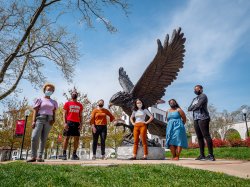Red Hawks Help CDC Improve Mask Wearing
Montclair State students collect data to improve mask wearing and fight COVID-19
Posted in: Health, Homepage News, Human Services, University

Last spring, Montclair State, along with several other universities, participated in a mask mitigation study directed by the Centers for Disease Control and Prevention.
“The feedback from this study can be used to create proper messaging for the future to promote healthy behaviors,” says Stefanie LoBue, a Master of Public Health (MPH) student, and one of 13 Red Hawks who volunteered as observers for an eight-week period, collecting data at 10 sites throughout campus.
Each student was stationed at a site for one hour each week to record approximately 40 observations which were entered on a CDC-provided data capture form. (No personal identifying information was collected.) The goal was to log 400 observations each week and submit that data to a CDC-managed database. The CDC shared the information back with participating universities so that the information could inform decisions in real time.
“This study was important because college campuses are prime for the transmission of COVID and it was important to understand how seriously and consistently college students were wearing masks,” says Breon Boseman-Sims ’21 MPH. “Although I felt it did not fully capture mask-wearing habits – most of the sites were big campus hubs where people were required to wear masks already like the Rec Center and Student Center – it was good to get a sense of how students were wearing masks and if they were wearing them correctly.”
Assistant Director of Health Promotion Marie Cascarano was the study’s Principal Investigator and of the 13 student observers, four were Health Promotion students and nine were undergraduate students who worked as Community Health Ambassadors (CHAs). The CHAs support public health initiatives related to the University’s COVID-19 Plan and COVID-19 safety guidelines. Although paid in their CHA roles, the students volunteered their time for the CDC study.
And the study yielded a lot of good news.
Says LoBue: “In observing behaviors, I was surprised by the compliance of almost all MSU students wearing masks, and wearing them properly.”
“I was very relieved to find that the majority of people I observed through this study were properly masking indoors on the Montclair campus,” says second-year MPH student Cassidy Walsh.
However, the students’ observations showed that there was still work to be done: “I was surprised by how many people were wearing surgical masks compared to cloth masks, especially since sustainability is very important to me,” says Walsh.
“Most students were wearing their masks, although there were always 2-10 people wearing them incorrectly out of the 40 we would observe within the hour,” says Boseman-Sims, who noted that, despite the use of surgical and paper masks, “most people utilized cloth masks instead.”
Both LoBue and Boseman-Sims noticed that those forgoing masks or wearing them improperly were sometimes not students. Says Boseman-Sims, “I also was surprised at the number of faculty/staff that had no mask in sight. I see it even more now as the campus community has returned this semester.”
A great and meaningful opportunity
Cascarano notes that the most difficult part of the task for the study’s CHAs was not to interact with people and ask them to wear or fix their masks – something that is part of their duties when they are on the clock and working as CHAs.
But the students, both CHAs and Health Promotion, were nonetheless eager to volunteer. Walsh says the prestige of participating in a study directed by the CDC was a major attraction.
She and others also stressed a personal call to do the work. Debree Rucker ’21 who graduated last spring with a degree in Family Science and Human Development, lost her grandfather to COVID-19. “I don’t want anyone to go through what my family went through,” Rucker told the news center last spring. “I want students and faculty to fully comprehend just how important these preventative measures are.”
Ashley Peralto ’21, a Pre-med, Molecular Biology major with a minor in Art History, adds, “The pandemic has taken such a significant toll on everyone. I was eager and glad to do this study because having been through COVID myself, as well as my loved ones, I wanted to do something meaningful for my community. Lastly, I dedicate this study to my grandma, who survived COVID-19 in April 2020 after being hospitalized, as well as to the health-care workers who have been working tirelessly and nonstop to help end these hard times.”
Meanwhile, Boseman-Sims is thinking ahead: “I feel as if it would be good for Montclair State to do their own mask observation study once during the semester to gauge how students are wearing masks now that people are fully back on campus.”
The CDC Mask Mitigation Study/Montclair State participants include:
Principal Investigator
Marie Cascarano, Assistant Director, Health Promotion, Campus Recreation and Intramural Sports
Health Promotion Graduate Coordinators
Stefanie LoBue
Breon Boseman-Sims
Cassidy Walsh
Health Promotion undergraduate student
Ashley Peralta
Community Health Ambassadors (CHAs)
Christie Rosales
David Olamiju
Debree Rucker
Imani Oslin
Manny Wheagar
Kayla Mccullough
Marshawn McShan
Nana Akua Brookman
Jasmine Metellus
Story by Staff Writer Mary Barr Mann
You may also like:
Principal Gives Pupils Extra Credit for Masks
Wearing is Caring
Positive Peer Pressure
